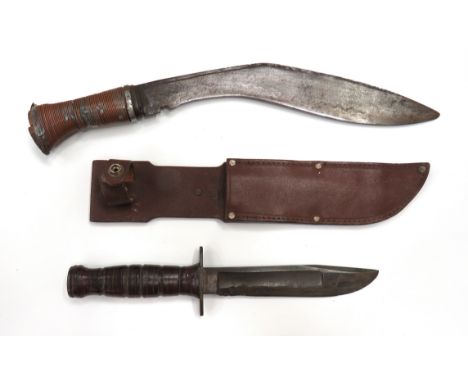We found 7480 price guide item(s) matching your search
There are 7480 lots that match your search criteria. Subscribe now to get instant access to the full price guide service.
Click here to subscribe- List
- Grid
An early 20th century Scottish Dirk, with single edged steel blade, 31cm and ornately carved wooden handle (lacking coloured stone pommel and sheath) and an Indian Kukri. (2)Note: You must be over 18 to purchase this item. Collection must be made in person or by arrangement with a delivery company that provides an age verification service. We do not provide a shipping service for bladed items.
Post WW2 Israel Combat KnifeAmerican pattern, 6 3/4 inch, single edged, clipped point blade. Large fuller. Forte with Israel star. Oval, steel crossguard. Steel disc pommel. Leather washer grip. Contained in its leather scabbard. Blade combat sharpened. Together with an Indian kukri. 12 1/4 inch blade. Copper wrapped wooden grip. Heavy usage. 2 items.
A COLLECTION OF KNIVES, to include various Eastern style curved knives and a German RAD Style knife, also included is a Kukri in its scabbard, a small knife with a faux horn handle, two curved knives in scabbards, three small knives with magnetic handles and a German RAD knife with a black handle with an eagle on it that we believe is for reenactors to use
An Indian Kukri, with wrigglework decoration to the steel blade, horn hilt and leather scabbard with two sharpening knives; a Similar Indian Kukri, with velvet covered scabbard decorated with raised gilt metal thread embroidery; two Small Indian Fantasy Daggers, with gilt metal hilts; an Indian Dagger, with carved wood grip and scabbard; a Quantity of Ephemera, including Second World War copy newspapers and posters; two Royal Artillery Cap Badges, in brass with sliders (qty)
Two Early 20th Century Sgian Dubh, each with 9cm fullered and scallop back steel blade, the ebony grip carved with basket weave and applied with the crest of a rampant lion holding a flag and standing on a castle turret, with nickel mounts and leather scabbards, 22cm (af); two Nepalese Kukri, one with steel bolster incorporated within the tang, with wood grips and elliptical steel butt plate, lacking scabbard, the other with brass bolster and butt plate and with leather scabbard (4)
A small vintage Indian / Nepalese presentation Kukri knife dress dagger. Carved bone hilt with white metal bands and rivets, typical curved blade and a velvet wrapped scabbard with white metal floral mounts. Measures approx 25cm. If this lot is required to be posted please see sale notes regarding age verification.
A vintage Nepalese / Gurkha Regiment Kukri knife dagger. The knife having a capped brass pommel with diamond lozenge and a carved wooden grip. The blade of typical form housed within a leather wrapped wooden scabbard with Karda and Chakmak knives present. Measures approx 38cm. If this lot is required to be posted please see sale notes regarding age verification
Woodyatt (Nigel G.). The Regimental History of the 3rd Queen Alexandra's Own Gurkha Rifles, 1st edition, London: Philip Allan & Co., 1929, monochrome frontispiece, folding maps, bookplate to the front pastedown, half-title through to frontispiece detached, some light toning & spotting, original gilt decorated green cloth, boards slightly marked, head of the spine dented, 8vo, together with:Mullaly (B. R., et al), Bugle and Kukri, the story of The 10th Princess Mary's Own Gurkha Rifles, 3 volumes, mixed editions, London: William Blackwood & Sons/The Regimental Trust, 1957-2000, colour & monochrome illustrations, bookplate & later inscription the front endpapers of volume 1, some minor toning, all original cloth, volumes 2 & 3 in dust jackets, 8vo, plusMorris (C. J.), Handbooks for the Indian Army, Gurkhas, 2nd edition, Dehli: Manager of Publications, 1936, 2 folding tables to the rear, ex-libris book plate to the front pastedown, lacking front endpaper, some light marginal toning, original boards to black cloth spine, rubbed, 8vo, and other early 20th Century & modern Gurkha reference & related, mostly original cloth, some in dust jackets, 8voQTY: (31)
An important ‘V-Beach’ First Day of the Gallipoli landings Mentioned in Despatches group of four awarded to Lieutenant-Colonel G. A. Rosser, Machine Gun Officer, 2nd Battalion, Hampshire Regiment, later Armoured Car Division and Royal Tank Corps, who directed 11 machine guns mounted on the bow of the River Clyde and prevented a ‘position of dire peril’ turning into a complete failure 1914-15 Star (Capt. G. A. Rosser. Hamps. R.); British War and Victory Medals, with M.I.D. oak leaves (Major G. A. Rosser.); India General Service 1908-35, 2 clasps, Malabar 1921-22, Waziristan 1921-24 (Capt. G. A. Rosser, R. Tank. C.) the Great War trio fine, the IGS better, the Malabar clasp rare to unit (4) £700-£900 --- Provenance: Bill Green Collection of Medals to the Tank Corps, Dix Noonan Webb, April 2004. George Archibald Rosser was born in Strawberry Hill, Middlesex, on 3 March 1890, the son of Colonel Rosser of 2, Eaton Villas, Hove. Educated at Wellington College, he was appointed to a commission in the Hampshire Regiment on 18 September 1909 and returned with the 2nd Battalion from India to England at the outbreak of the Great War. Gallipoli - The River Clyde affair Posted aboard the SS River Clyde on 25 April 1915, Rosser witnessed the beaching of the collier at ‘V’ beach beneath a devastating fire. Adapted as a ‘Trojan Horse’ with openings cut in her steel hull as sally ports, the men of the 1st Royal Munster Fusiliers, 2nd Hampshire’s and 1st Royal Dublin Fusiliers disembarked as sitting ducks and soon found themselves wading through shoulder-deep water. According to Gallipoli: The Landing: ‘so murderous and accurate was the fire, mainly machine-guns, that a handful achieved their purpose and the gangways and lighters were soon crowded with dead and wounded... A few managed to wade ashore but after No. 9 Platoon of Y Company had lost its commander, Captain Boxall, mortally wounded, and nearly 20 men in a gallant attempt to get ashore, Colonel Carrington-Smith, senior officer on board the Clyde, stopped further efforts as merely entailing useless sacrifice of life.’ Appreciating the failure of the pre-landing naval bombardment - even with 12-inch guns - to neutralise Turkish machine guns and pom poms in the fort above the beach, Rosser and his machine gun teams attempted to offer a glimmer of hope to those men pinned down along 300 yards of sand: ‘Meanwhile, the battalion’s machine guns on board the Clyde under Lt. Rosser and some R.N.D. guns were trying hard to keep down the machine-gun fire and giving effective covering fire to the men ashore, but the well-concealed Turkish guns were hard to locate and harder to silence.’ At 3pm Colonel Carrington-Smith was hit and killed on the bridge of the River Clyde. His death coincided with a brief slackening of enemy fire caused by a fresh pounding by three battleships, but for the men ashore, Rosser’s machine guns proved essential to their survival until sunset. An extract from The Story of the 29th Division by Captain Stair Gillon, confirms: ‘Only the machine guns in the bow of the River Clyde, ably controlled by Lieutenant G. A. Rosser of the 2nd Hants and Commander Josiah Wedgwood, M.P., of the R.N.D., the morale effect of the naval guns, and possibly the barrier of wire, prevented the Turks from counter-attacking and annihilating the party at the water’s edge.’ For this work, Rosser was Mentioned in Despatches (London Gazette 3 August 1915). Appointed Battalion Adjutant, he later fought at the First and Second Battles of Krithia, being one of just four officers and 204 men present for roll call on 9 May 1915. Withdrawn to a reserve position to recover, Rosser fought his final action on the Peninsula at the Third Battle of Krithia from 4 to 6 June 1915. After receiving a gunshot wound to the thigh, he was evacuated to Mudros and then posted in early 1916 to the Machine Gun Corps Training Centre at Belton Park as Assistant instructor. Raised Major, he was given command of the newly formed 133rd Company, Machine Gun Corps, and directed overseas. Mesopotamia Arriving in Turkish Mesopotamia on 19 December 1916, Rosser’s time is carefully detailed in his own hand in the official war diary of the 133rd Machine Gun Corps; witnessing first action on 24 December 1916, his unit was heavily engaged in attacking Turkish positions on the right bank of the Tigris at Khudhaira Bend on 9 January 1917; placed in positions around the Abdul Hassan Bend sector, providing support for an infantry assault, his men suffered the loss of one machine gun and a number of casualties in the face of a determined enemy in hand to hand combat. Further engagements included the Battle of Jebel Hamrin and the Battle of Megiddo, where the 133rd M.G.C. were directed in support of 9th Brigade’s attempts to break through the Tabsor defences at Sabiye and advance east towards Qalqilye, Kh. Kefar Thilth, ‘Azzun and Jiyus in the foothills of the Judean hills. For his leadership in Mesopotamia, Rosser was again Mentioned in Despatches (London Gazette 15 August 1917) and was promoted Temporary Major. Malabar Attached to 8th Armoured Car Company at Lahore in September 1921, Rosser was placed in command of 25 men, four armoured cars, one Peerless lorry, one Ford touring car and two motor cycles during a period of open rebellion in Kerala, India. His second in command, Lieutenant Dawson, was keen to note: ‘We replaced the cavalry; the field artillery were replaced by pack artillery. The flat footed Indian Infantry were replaced by Gurkha and Burmese Regiments... The war became a series of tiger hunts. The infantry were the beaters, the artillery the side stops and we were the guns shooting up anyone that attempted to cross our tracks.’ It was later said that the Mophals developed a healthy respect for the armoured cars as no convoy was attacked when escorted by one. On 20 October 1921, the whole section took part in combined operations with the Gurkhas and Dorset Regiment and managed to engage a band of rebels, killing 46 - mostly with the kukri. In another operation named ‘Melmur Drive’, all four of Rosser’s armoured cars, supported by the 2nd Battalion, Dorset Regiment, engaged and killed 246 of the enemy; shortly afterwards, petitions were received from the rebels in the neighbourhood of Malappurum offering their submission. Transferred to operations with No. 9 Armoured Car Company in January 1922, Rosser served on the Takhi Zam line to the south of Waziristan. Posted to Cairo in command of No. 3 Armoured Car Company in 1927, he transferred to the 5th Royal Tank Corps in England and in 1934 had the distinction of becoming the first commanding officer of the 1st (Light Battalion), Royal Tank Corps, equipped with the Vickers Mk. II and Mk. III tanks. Retired on 13 April 1935, Rosser died at Vancouver in Canada on 24 April 1950. Sold with extensive copied research, including an article about the recipient published in the March 2018 Journal of the O.M.R.S.
A Kukri knife with bone handle, 9" blade, the scabbard with brass decoration together with a World War One German Mauser bayonet by Weaversberg Kirschbaum Solenge, the spine marked with a crown W 15. This bladed product is not for sale to people under the age of 18. By bidding on this item you are declaring that you are 18 years of age or over. Please note that if you require P&P for this lot, this can only be done using an age verified method.




























































